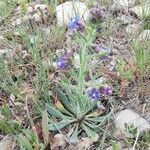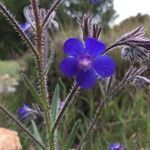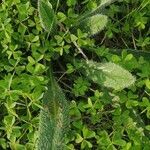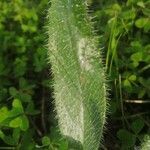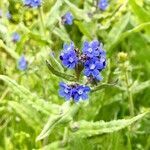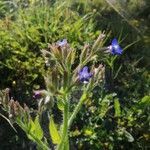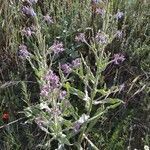Perennial, hispid with dense, patent, rigid or soft, often tubercle-based hairs; stems 20-150 cm, erect. Leaves (50-)100-300 x (10-)15-50 mm. Cymes many; pedicels 1-3 mm, up to 10(-15) mm in fruit; bracts shorter than calyx. Calyx 6-8(-10) mm, up to 18 mm in fruit, divided almost to the base into linear, acute lobes. Corolla violet or deep blue; tube 6-10 mm, slightly exceeding or shorter than calyx; limb (8-)10-15 mm in diameter; stamens inserted at top of tube, overlapping scales. Nutlets (6-)7-10 x 2-3 mm, oblong or oblong-obovoid, erect.
Perennial herb, 0.2-1.5 m high, roughly hairy with long, white bristles. Leaves with blade ovate to narrowly obovate-elliptic, up to 140 x 20 mm, apex acute. Flowers in scorpioid cymes. Calyx divided ± to base; lobes narrowly ovate, 6-8 mm long in flower, 12-15 mm long in fruit. Corolla tube equalling or longer than limb; limb (8-)10-15 mm in diam.; corolla with tube ± 6 mm long, lobes ± 4 mm long, violet or deep blue. Flowering time Oct.-Mar. Fruit of erect nutlets, longer than wide, at least 6 mm long.
Perennial herb, 0.2-1.5 m high, roughly hairy with long, white bristles. Leaves with blade ovate to narrowly obovate-elliptic, up to 140 x 20 mm, apex acute. Flowers in scorpioid cymes; calyx divided ± to base, lobes narrowly linear, 6-8 mm long in flower, 12-15 mm long in fruit, apices acuminate; corolla with tube, ± 6 mm long, equalling or longer than limb, limb (8-)10-15 mm in diameter, lobes ± 4 mm long, violet or deep blue; Oct.-Mar. Fruit an erect nutlet, longer than wide, at least 6 mm long.
Perennial herb, 0.2-1.5 m high, with long, white bristles. Calyx divided ± to base. Corolla tube equalling or longer than limb, limb (8-)10-15 mm in diameter. Nutlets longer than wide, at least 6 mm. Flowers violet or deep blue.
A herb that keeps growing from year to year. It grows 45-120 cm high and 45-60 cm wide. The stems are red and have bristles. The lower leaves are 30 cm long. The leaves are hairy. The flowers are saucer shaped and bright blue.
